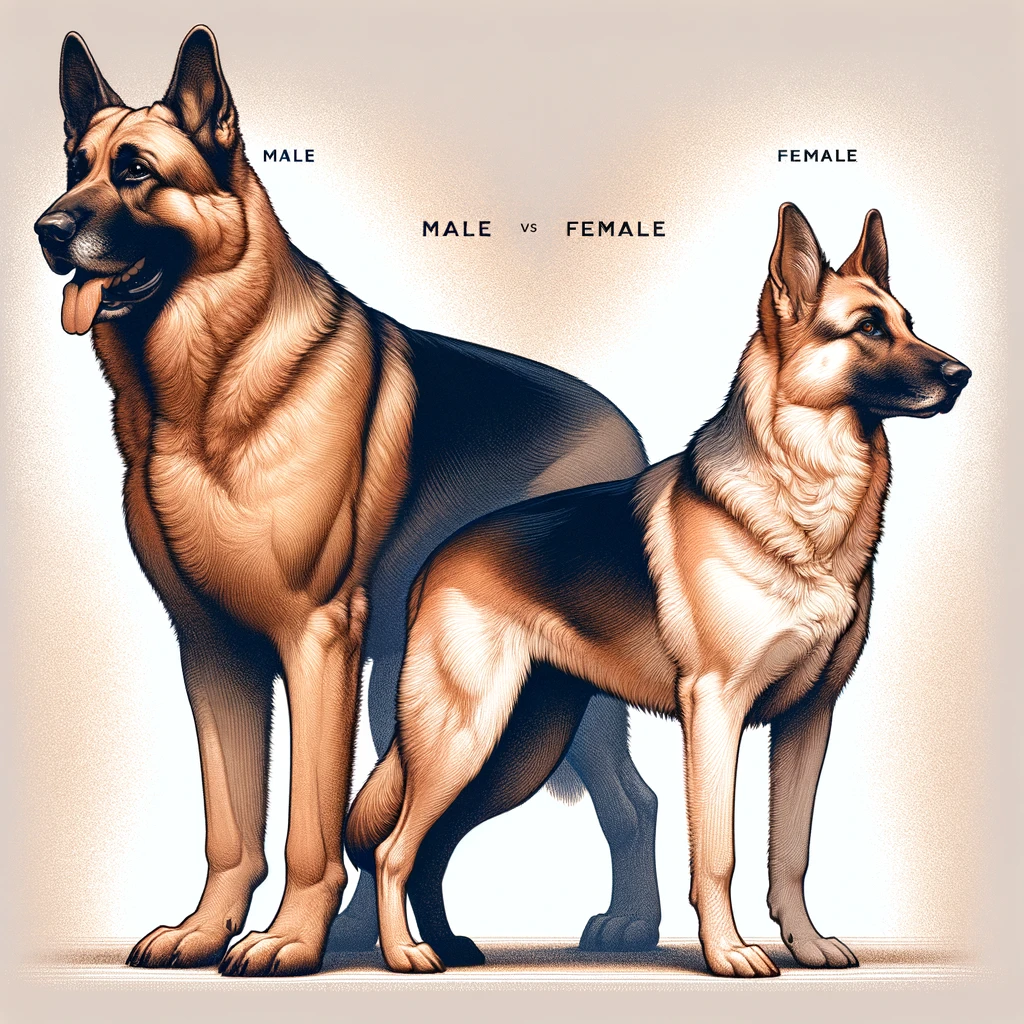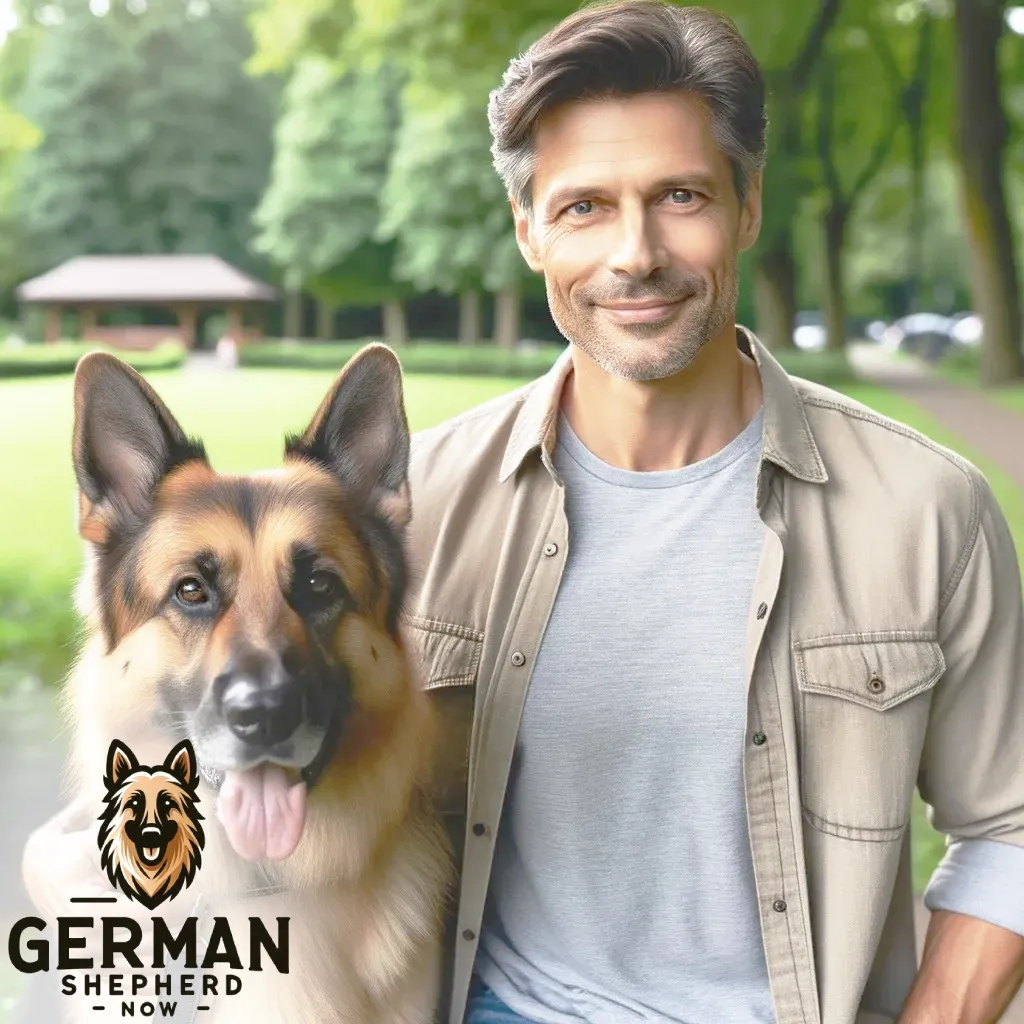Choosing a German Shepherd: Male vs Female
Selecting the perfect German Shepherd for your family requires careful thought, especially when choosing between a male or female. Each has distinct qualities and behaviors that could match well with your lifestyle and what you’re looking for in a pet.
Males are usually bigger and bolder, making them great for specific jobs and training activities. Females are often smaller, more caring, and protective, providing a unique companionship experience.

German Shepherd: Male vs Female Comparison
When considering adding a German Shepherd to your family, it’s important to understand the differences between males and females.
These distinctions can help you choose the right dog for your lifestyle, whether you’re looking for a companion, a working dog, or a family pet. Below is a detailed comparison of male and female German Shepherds across several key aspects.
| Aspect | Male German Shepherd | Female German Shepherd |
| Size | Larger and more muscular, weighing between 65 and 90 pounds and standing 24 to 26 inches tall at the shoulder. | Smaller and lighter, typically weighing between 50 and 70 pounds and standing 22 to 24 inches tall. |
| Temperament | More dominant and territorial, they can be assertive and sometimes more challenging to train due to their bold nature. | Generally more reserved and less aggressive, often maturing faster mentally, making them potentially easier to train. |
| Protectiveness | Possess strong protective instincts, often displaying a more aggressive form of protection, making them excellent guard dogs. | Display a nurturing kind of protectiveness, more likely to be protective in a gentle manner, particularly good with children. |
| Training and Obedience | May show stubbornness but excels in obedience and task-oriented training with the right approach, great for competitive and work environments. | Tend to be easier to train due to their eagerness to please and sensitivity to commands, making them excellent for obedience and agility tasks. |
| Social Behavior | Can be more independent and may require more effort to socialize with other dogs and people. | Often more adaptable and can integrate more smoothly into homes with other pets or animals. |
| Health and Lifespan | Prone to similar breed-specific health issues but may have different risks due to larger size and hormonal differences. | Share common health concerns with males, though reproductive health issues are specific to females, manageable through spaying. |
| Bonding | Forming strong bonds with their owners can sometimes be more aligned towards a single person in the household. | Also, form deep attachments but may distribute their affection more evenly among all family members. |
| Maintenance | A larger size means potentially more food consumption and possibly higher costs for medication based on weight. | Slightly less food consumption and medication costs due to smaller size, but may require additional care related to reproductive health. |
| Lifespan | Generally healthy with a 9 to 13 years lifespan, similar to females, with proper care. | Slightly longer lifespan on average, though differences are minimal and largely influenced by health and care. |
| Ideal For | Suited for active individuals or families who work in security or competitive training environments. | Great for families, as service or therapy dogs, or for owners looking for a slightly less intense companion dog. |
German Shepherd: Male vs Female
While individual personality can vary within any breed, certain traits are observed among males and females. These differences encompass physical size, temperament, and behavioral tendencies, each playing a significant role in integrating into homes, work, and training environments.
Physical Differences
Size and Stature
Males: German Shepherds are generally larger and more muscular than their female counterparts. They weigh between 65 to 90 pounds and stand about 24 to 26 inches tall at the shoulder. Their larger size contributes to a more imposing presence, which can be an asset for security or law enforcement roles.
Females: Female German Shepherds tend to be smaller, weighing between 50 and 70 pounds, with a height of 22 to 24 inches. Their more petite stature makes them less intimidating, which might be preferable for families, especially those with children.
Temperament
Social Behavior and Dominance
Males: Males can be more dominant and territorial, traits often linked to their instinct to protect and mark their territory. This assertiveness can translate into a more confident and sometimes aggressive demeanor, especially if not trained and socialized from a young age.
Females: Females, while still protective, generally exhibit a more reserved and less aggressive nature. They can be quicker to mature mentally, making them easier to train in family living. Their protective instinct is more focused on nurturing, which can translate into a gentler approach toward family members.
Training and Obedience
Learning and Cooperation
Males: The assertiveness of male German Shepherds can sometimes make training a challenge, particularly with an inexperienced owner. They may exhibit stubbornness, requiring consistent and firm training methods. With the right approach, males excel in obedience and task-oriented training, often standing out in competitive and work-based environments.
Females: Females are often considered easier to train due to their quicker maturation and eagerness to please their owners. They tend to be more sensitive to their owner’s commands and corrections, which can help a smoother training process, especially in tasks that need attention to detail and consistency.
Health and Lifespan
General Health Concerns
Males and Females: Both genders are susceptible to common health issues within the breed, such as hip dysplasia, elbow dysplasia, and degenerative myelopathy. Hormonal differences can influence the prevalence of certain conditions. For instance, females may face specific reproductive health issues if not spayed, while males may exhibit different behavioral problems related to their testosterone levels.
Lifespan
The lifespan of a German Shepherd ranges from 9 to 13 years, with minimal variation between genders. Proper care, including regular veterinary check-ups, a healthy diet, and ample exercise, is paramount for males and females to lead a long, healthy life.
The Benefits of Having a Female German Shepherd
Choosing a female German Shepherd can bring unique advantages to your home and life. These intelligent and versatile dogs are known for their loyalty, agility, and protective instincts, making them outstanding companions for individuals and families.
Below are the positive aspects of having a female German Shepherd as part of your household:
1. Quicker Maturity
Female German Shepherds often mature faster than males, both physically and mentally. This early development can facilitate training and integration into family life.
2. Easier to Train
Thanks to their quick maturity and eagerness to please, female German Shepherds are generally considered easier to train. They respond well to commands and can excel in obedience and agility training.
3. More Reserved Temperament
Females tend to have a more reserved nature compared to their male counterparts. This can make them less prone to unnecessary aggression, making them excellent for families.
4. Protective Instincts
While both genders are protective, females often display a nurturing kind of protectiveness. This instinct can make them particularly attentive when looking after children.
5. Smaller Size
The slightly smaller stature of female German Shepherds can be an advantage for those living in smaller spaces or families with young children, as they can be easier to manage.
6. Less Territorial
Females are generally less territorial than males, which can result in fewer aggressive displays towards strangers and other animals, reducing the likelihood of confrontations during walks or in the yard.
7. Strong Bonding
Female German Shepherds are known for forming deep bonds with their primary caregivers. They often become closely attached to one person, offering a profound sense of companionship.
8. Lower Dominance Issues
With a less dominant nature, female German Shepherds can integrate more smoothly into households with other pets, potentially reducing the challenges of multi-pet dynamics.
9. Versatility
Their intelligence and adaptable temperament make female German Shepherds suitable for various roles, including as service dogs, therapy dogs, and family pets.
10. Health Considerations
While both genders are prone to certain health issues, the management of health in females is well-understood, especially regarding reproductive health, which can be effectively managed through spaying.
Challenges of Owning a Female German Shepherd
Owning a Female German Shepherd can be a rewarding experience, given their intelligence, loyalty, and protective nature. Prospective owners should know certain challenges specific to female German Shepherds.
Understanding these issues can help provide the best care and training for these remarkable dogs, ensuring a happy and healthy life together. Here are ten potential challenges you might face with a female German Shepherd:
Heat Cycles
Female German Shepherds who are not spayed will undergo heat cycles twice a year. This period can be marked by behavioral changes, bleeding, and the attraction of male dogs, which can be challenging to manage, especially in urban living environments.
Spaying Considerations
Deciding when or if to spay your female German Shepherd carries its considerations. Spaying too early or too late can have health implications, including risks of certain cancers or joint issues. It’s important to consult with a veterinarian to make an informed decision.
Potential for Moodiness
Some female German Shepherds can exhibit mood swings, especially around their heat cycles. This can affect their training and interaction with family members or other pets.
Maternal Instincts
Their strong maternal instincts can sometimes manifest as overprotectiveness or even aggression, particularly if they perceive a threat to their home or family. This requires careful management and socialization from a young age.
False Pregnancy
After a heat cycle, some females may experience a false pregnancy, displaying symptoms like nesting, lactation, or mothering of toys. While not harmful, it can be unclear and requires the owner’s understanding and patience.
Size and Strength
Though generally smaller than males, female German Shepherds are still powerful dogs, their size and strength can be challenging for owners who are unprepared for the physical demands of handling and training them.
Training and Socialization Needs
Like all German Shepherds, females require consistent training and socialization. Their sensitivity and intelligence mean they may respond differently to training methods, requiring a more nuanced approach.
Health Issues
Female German Shepherds are prone to certain health issues, such as hip dysplasia and autoimmune diseases. Regular veterinary care and preventive measures are essential to manage these risks.
Attachment and Separation Anxiety
Females can form intense attachments to their owners, leading to potential separation anxiety. This can manifest in destructive behavior or distress when left alone, requiring careful training to mitigate.
Resource Guarding
Some female German Shepherds may exhibit resource guarding with more intensity, such as protecting food, toys, or even people. This behavior requires early intervention to ensure it doesn’t escalate into aggression.
Tail-Wagging Conclusion
Choosing a male or female German Shepherd depends on knowing their different qualities to find the best match for your home and way of life. Male German Shepherds are bigger and bold, great for people who want a strong and guarding friend, and good for jobs or training.
Female German Shepherds are caring and protective, grow up faster, and usually learn quicker, making them great for families or anyone who wants an easier-to-handle dog. You must consider what each gender offers, how it fits your needs, and where you live to ensure you and your German Shepherd have a happy life together.

I’m Martin, and I grew up in the super cool city of Seattle. You know, the place with all the incredible mountains and forests? Yeah, that’s my playground!
Ever since I was little, I’ve been all about nature. I used to wander around the woods with a notebook, doodling all the cool plants and animals I’d find.
